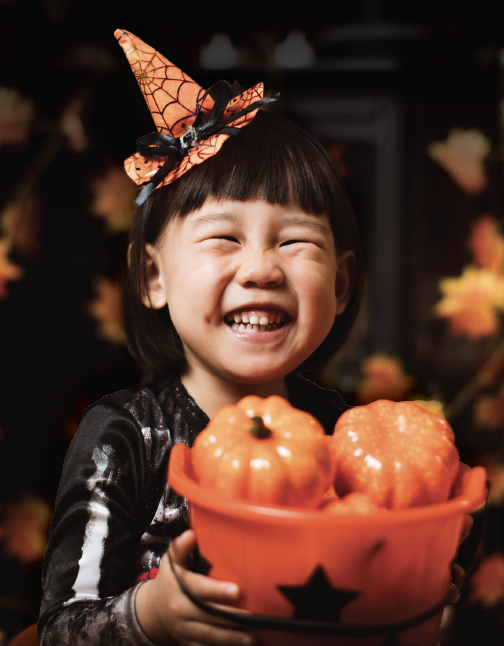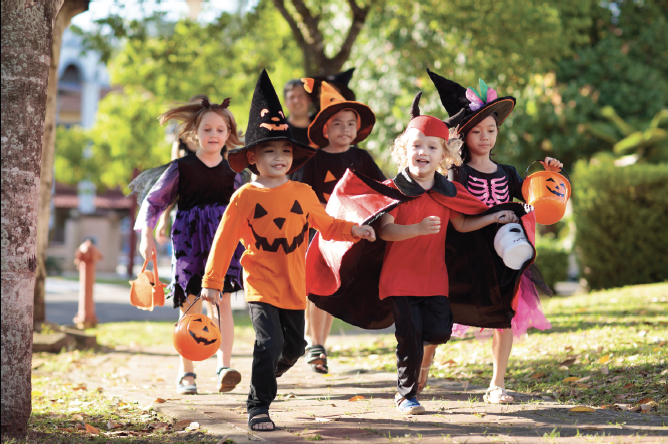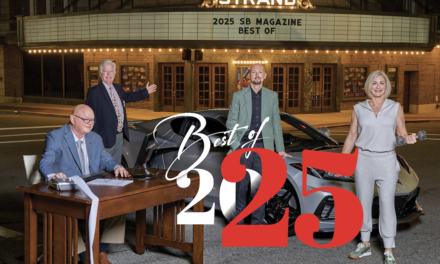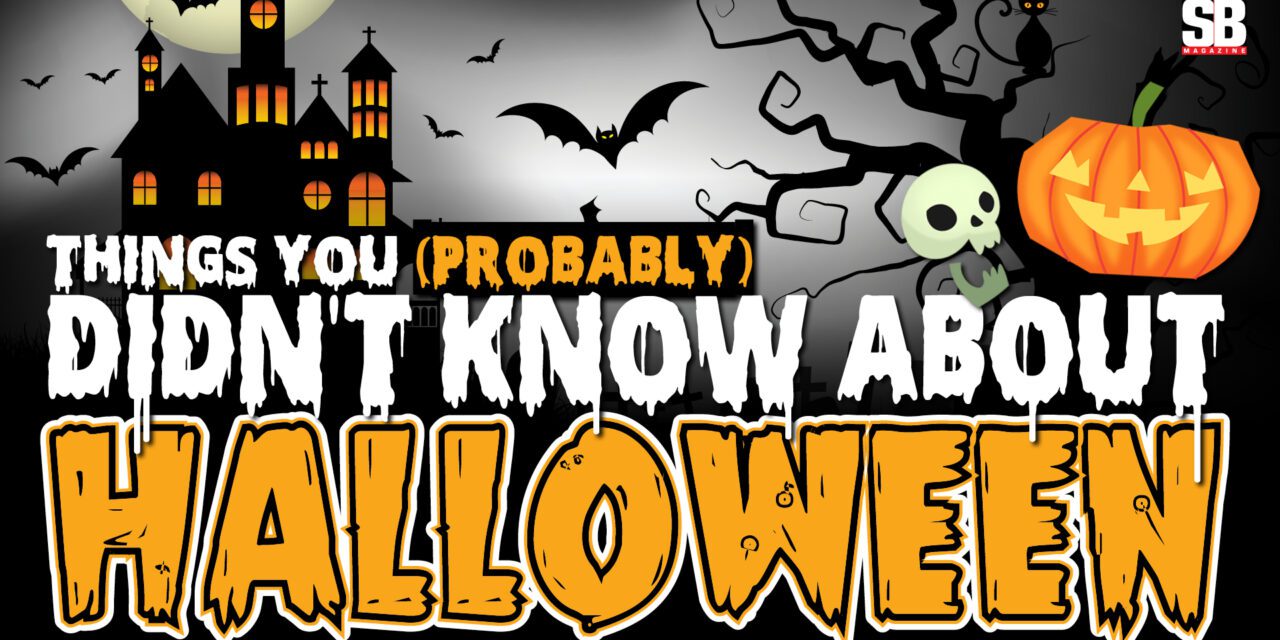BY ADAM BAILEY
Every October 31st, people all over the world(or at least in most parts of Europe, NorthAmerica, and Latin America) celebrate the ancient holiday of Halloween, also known asAll Hallows’ Eve. Although today it features costumes, trick-or-treating, haunted houses and ghost stories, it wasn’t always that way. Here are some things most people didn’t know about Halloween:
Halloween is More Irish than St. Patrick’s Day
Whereas St. Patrick’s Day was invented in America by Irish-Americans, Halloween’s origins likely evolved from the ancient Celts. The celebration of Samhain—which in very ancient days was a ritualistic festival that honored the pagan gods of the harvest—was a time when the wallbetween our world and the paranormal world was porous and spirits could get through. Because of this belief, itwas common for the Celts to wear costumes and masks during the festival to ward off or befuddle any evil spirits.
Samhainophobia
Many people enjoy embracing the spooky spirit of Halloween, but for some, the fear is not all in good fun. Some people suffer from Samhainophobia, according to Newsweek, the fear of Halloween.
Show Me the Money!
Halloween is the second-most commercial American holiday after Christmas. According to History.com, approximately 8 billion dollars is spent annually, with over 2.6 billion dollars being spent on costumes alone (with plenty more being shelled out for trick-or-treat candy and decorations). 330 million dollars will be spent on pet costumes.

Candy, Candy, and More Candy Did you know that more sweets are sold on October 28th than any other day?
It’s true! Reports show that supermarkets sell more sweets and confectionery three days before
Halloween than any other day of the year. What’s the number one candy of choice? According to CandyStore.com, the top candy last year was Skittles, followed by Reese’s Cups and Starburst. What’s the least favorite? You guessed it, Candy Corn.
Candy Corn was Originally Known as
“Chicken Feed”
Invented by George Renninger, a candy maker at the Wunderle Candy Company of Philadelphia in the 1880s, Candy Corn was originally called “butter cream candies” and “chicken feed” since back then, corn was commonly used as food for livestock. They even had a rooster on the candy boxes. It had no association with Halloween or fall, and was sold seasonally from March to November. After World War II, advertisers began marketing it as a special Halloween treat due to its colors and ties to the fall harvest.
The Candy Industry Supposedly Influenced Daylight Savings Time According to the book, Spring Forward:
The Annual Madness of Daylight Savings Time, the candy industry played a major role in changing the length of Daylight Savings. Candy makers supposedly lobbied to extend daylight savings time into the beginning of November to get an extra hour of daylight so children could collect even more candy (thus forcing people to purchase more candy to meet the demand).
Fears of Poisoned Halloween Candy are Unfounded
One of parents’ biggest fears is that their child’s Halloween candy is poisoned or contains razor blades. In reality, this fear is almost entirely unfounded. There are only two known cases of poisoning, and both involved relatives, according to LiveScience. In 1970, a boy died of a heroin overdose. The investigators found it on his candy, but in a twist they later discovered the boy had accidentally consumed some of his uncle’s heroin stash, and the family had sprinkled some on the candy to cover up the incident. Even more horrifically, in 1974 Timothy O’Bryan died after eating a Pixy Stix his father had laced with cyanide to collect on the insurance money, according to Smithsonian Magazine.
Seeing a Spider on Halloween is Actually a Good Thing
According to legend, if you see a spider on Halloween, it’s actually the spirit of a loved one watching over you. That is part of why spiders appear so often in Halloween media and decorations. That and the fact that they look creepy and scare people. You can’t help but to question why, of all the signs your ancestor could send from beyond the grave, they would choose an eight-legged creepy-crawly.
Trick-or-Treating is from Celtic Tradition
In the UK, trick-or-treating is known as ‘guising’—a historic word meaning to dress up or wear a disguise. The origins of the Halloween tradition actually stem from the Celtic festival of Samhain that coincides with Halloween. During the festival, people would put out food to appease the spirits that roamed the streets during the night. Guising comes from this idea with the guisers taking on the role of the spirits and traveling from door to door searching for treats. In Great Britain, this tradition dates back to the 16th century whilst in North America, it was first recorded in 1911 in Ontario, Canada.
Trick-Or-Treating, as We Know it, Was Re-Popularized by Cartoons
Trick-or-treating was brought to America by the Irish and became popular during the early 20th century, but
died out during WWII when sugar was rationed. After the rationing ended in 1947, children’s magazine “Jack and Jill,” radio program “The Adventures of Ozzie and Harriet,” and the “Peanuts” comic strip all helped to re-popularize the tradition of dressing up in costumes and asking for candy from door-to-door. By 1952, trick-or-treating was hugely popular again.
A Full Moon on Halloween is Quite Rare
Though a common trope in horror movies and Halloween decorations with witches flying across the full moon, an actual full moon occurring on Halloween is not a common occurrence. The reality though is that, despite the supposed mysticism surrounding the full moon, it is unlikely to see one on Halloween itself. When will it happen again? You might want to plan accordingly because the next full moon on Halloween won’t occur until 2039.

Jack-O-Lanterns are Named After a Man Named Stingy Jack
The origin of Jack-O’-Lanterns comes from a Celtic folk tale of a stingy farmer named Jack who would constantly play tricks on the devil. The devil responded by forcing him to wander purgatory with only a burning lump of coal from hell. Jack took the coal and made a lantern from a turnip, using it to guide his lost soul. The myth was brought over by Irish families fleeing the potato famine in the 1800s, and since turnips were hard to come by in the U.S., America’s pumpkins were used as a substitute to guide lost souls and keep evil spirits like “Jack of the Lantern” away.
Pumpkins are Not Always Orange
Every time you see a Jack-O’-Lantern either in real life or on TV, they are always carved from an orange pumpkin. This is likely because the color orange has always been associated with Halloween. However, pumpkins actually come in a range of colors! They can be grey, white, red, or even green. Recently, white pumpkins have become more popular. Why not try carving a different colored pumpkin this year? It will make your Jack-O’-Lantern stand out!
New Hampshire Holds the Record of the Most Jack-O-Lanterns on Display
On October 19, 2013, Keene, New Hampshire, U.S., set a new record on the lighting the highest number of Jack-O’-Lanterns in one place. According to Guinness World Records, 30,581 lanterns were lit on display at Keene Pumpkin Festival organized by the “Let it Shine” group. Central Square’s tower was the event’s central attraction, while jack-o’-lanterns were displayed on Main Street.
Some Places Have Halloween Laws
Halloween is supposed to be a fun day where you can put on a costume and eat sweets—but some places have strict rules about that fun. In Alabama, it
is illegal to dress up as a priest. That includes all those tacky store-bought costumes.
Meanwhile, in Hollywood, there is a
$1000 fine for anyone who uses silly string between 12:00am on October 31st to 12:00pm on November 1st. Any other day of the year, it is perfectly okay to use silly string. Do it on Halloween, however, and it will be the most expensive trick-or-treating you have ever done.
What’s in a Name?
Halloween has been called a number of things throughout the years including Hallowe’en, Allhalloween, All Hallows’ Eve, All Saints’ Eve, Lamswool, Samhain, Summer’s End, and Snap-Apple Night.
You’re Probably Spelling It Wrong
The correct spelling of Halloween
is actually Hallowe’en, a con-traction of All Hallows’ Eve.









